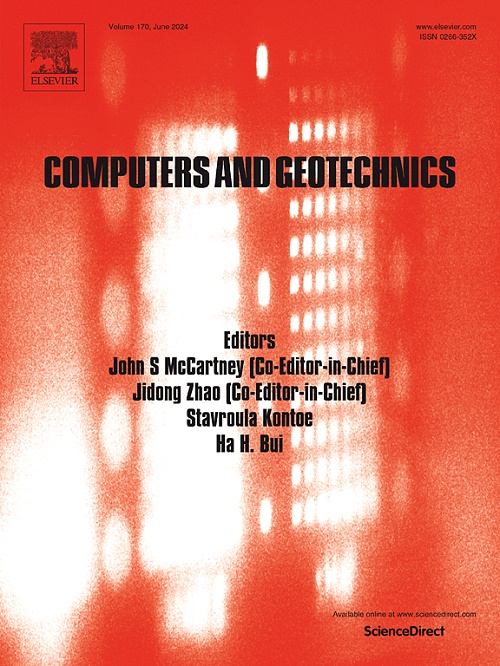Stabilized reduced-integration u-w coupled element for 3D dynamic modelling of saturated soils
IF 5.3
1区 工程技术
Q1 COMPUTER SCIENCE, INTERDISCIPLINARY APPLICATIONS
引用次数: 0
Abstract
Three-dimensional numerical analysis is crucial in revealing the complex dynamic behaviour of saturated soil under multidirectional loadings. In this study, the derivation and implementation of a stabilized reduced-integration coupled element based on the u-w formulated Biot theory are presented. The key improvement of this element is the modification of non-constant solid and fluid strains based on the enhanced strain method (ESM) and assumed strain method (ASM), which ensures its stability in the incompressible-impermeable limit while maintaining an efficient bilinear interpolation scheme. Additionally, a mixed integration scheme is also employed to reduce the computational cost. The performance of the proposed element is evaluated using two benchmark problems, and comparisons with analytical methods and other coupled elements demonstrate its superiority in terms of accuracy, stability, and efficiency. The applicability of the element in more complex geotechnical scenarios is further demonstrated by investigating soil liquefaction under uni- and bi- directional shakings. The results demonstrate that both the extent and severity of field liquefaction are significantly greater under bidirectional loadings compared to those under Airas-equivalent unidirectional loadings. This highlights the necessity of three-dimensional analyses for problems involving multidirectional loading conditions, as the negligence of out-of-plane loadings and strains in plane-strain analyses could result in unsafe engineering designs.
饱和土三维动力学模型的稳定减积分u-w耦合单元
三维数值分析对于揭示饱和土在多向荷载作用下的复杂动力特性至关重要。在本研究中,提出了一种基于u-w公式Biot理论的稳定化约积分耦合元件的推导和实现。该单元的关键改进是基于增强应变法(ESM)和假设应变法(ASM)对非恒定固流应变的修正,保证了其在不可压缩-不可渗透极限下的稳定性,同时保持了有效的双线性插值方案。此外,为了降低计算成本,还采用了混合积分方案。利用两个基准问题对所提出的单元的性能进行了评估,并与解析方法和其他耦合单元进行了比较,证明了其在准确性、稳定性和效率方面的优越性。通过研究单向和双向振动下的土壤液化,进一步证明了该单元在更复杂的岩土工程场景中的适用性。结果表明,双向载荷作用下的现场液化程度和严重程度均明显大于等效单向载荷作用下的现场液化程度和严重程度。这突出了三维分析涉及多向加载条件的问题的必要性,因为平面应变分析中忽略面外载荷和应变可能导致不安全的工程设计。
本文章由计算机程序翻译,如有差异,请以英文原文为准。
求助全文
约1分钟内获得全文
求助全文
来源期刊

Computers and Geotechnics
地学-地球科学综合
CiteScore
9.10
自引率
15.10%
发文量
438
审稿时长
45 days
期刊介绍:
The use of computers is firmly established in geotechnical engineering and continues to grow rapidly in both engineering practice and academe. The development of advanced numerical techniques and constitutive modeling, in conjunction with rapid developments in computer hardware, enables problems to be tackled that were unthinkable even a few years ago. Computers and Geotechnics provides an up-to-date reference for engineers and researchers engaged in computer aided analysis and research in geotechnical engineering. The journal is intended for an expeditious dissemination of advanced computer applications across a broad range of geotechnical topics. Contributions on advances in numerical algorithms, computer implementation of new constitutive models and probabilistic methods are especially encouraged.
 求助内容:
求助内容: 应助结果提醒方式:
应助结果提醒方式:


